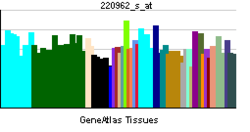- PADI1
-
Peptidyl arginine deiminase, type I Identifiers Symbols PADI1; HPAD10; PAD1; PDI; PDI1 External IDs OMIM: 607934 MGI: 1338893 HomoloGene: 7881 GeneCards: PADI1 Gene EC number 3.5.3.15 Gene Ontology Molecular function • protein-arginine deiminase activity
• calcium ion binding
• hydrolase activityCellular component • cytoplasm Biological process • protein modification process
• peptidyl-citrulline biosynthetic process from peptidyl-arginineSources: Amigo / QuickGO RNA expression pattern 
More reference expression data Orthologs Species Human Mouse Entrez 29943 18599 Ensembl ENSG00000142623 ENSMUSG00000025329 UniProt Q9ULC6 Q544I4 RefSeq (mRNA) NM_013358 NM_011059.2 RefSeq (protein) NP_037490 NP_035189.1 Location (UCSC) Chr 1:
17.53 – 17.57 MbChr 4:
140.37 – 140.4 MbPubMed search [1] [2] Peptidyl arginine deiminase, type I, also known as PADI1, is a protein which in humans is encoded by the PADI1 gene.[1][2]
This gene encodes a member of the peptidyl arginine deiminase family of enzymes, which catalyze the post-translational deimination of proteins by converting arginine residues into citrullines in the presence of calcium ions. The family members have distinct substrate specificities and tissue-specific expression patterns. The type I enzyme is involved in the late stages of epidermal differentiation, where it deiminates filaggrin and keratin K1, which maintains hydration of the stratum corneum, and hence the cutaneous barrier function. This enzyme may also play a role in hair follicle formation. This gene exists in a cluster with four other paralogous genes.[1]
References
- ^ a b "Entrez Gene: PADI1 peptidyl arginine deiminase, type I". http://www.ncbi.nlm.nih.gov/sites/entrez?Db=gene&Cmd=ShowDetailView&TermToSearch=29943.
- ^ Guerrin M, Ishigami A, Méchin MC, Nachat R, Valmary S, Sebbag M, Simon M, Senshu T, Serre G (February 2003). "cDNA cloning, gene organization and expression analysis of human peptidylarginine deiminase type I". The Biochemical Journal 370 (Pt 1): 167–74. doi:10.1042/BJ20020870. PMC 1223146. PMID 12416996. http://www.pubmedcentral.nih.gov/articlerender.fcgi?tool=pmcentrez&artid=1223146.
Further reading
- Vossenaar ER, Zendman AJ, van Venrooij WJ, Pruijn GJ (2004). "PAD, a growing family of citrullinating enzymes: genes, features and involvement in disease.". Bioessays 25 (11): 1106–18. doi:10.1002/bies.10357. PMID 14579251.
- Chavanas S, Méchin MC, Nachat R, et al. (2006). "Peptidylarginine deiminases and deimination in biology and pathology: relevance to skin homeostasis.". J. Dermatol. Sci. 44 (2): 63–72. doi:10.1016/j.jdermsci.2006.07.004. PMID 16973334.
- Maruyama K, Sugano S (1994). "Oligo-capping: a simple method to replace the cap structure of eukaryotic mRNAs with oligoribonucleotides.". Gene 138 (1–2): 171–4. doi:10.1016/0378-1119(94)90802-8. PMID 8125298.
- Suzuki Y, Yoshitomo-Nakagawa K, Maruyama K, et al. (1997). "Construction and characterization of a full length-enriched and a 5'-end-enriched cDNA library". Gene 200 (1–2): 149–56. doi:10.1016/S0378-1119(97)00411-3. PMID 9373149.
- Guerrin M, Ishigami A, Méchin MC, et al. (2003). "cDNA cloning, gene organization and expression analysis of human peptidylarginine deiminase type I". Biochem. J. 370 (Pt 1): 167–74. doi:10.1042/BJ20020870. PMC 1223146. PMID 12416996. http://www.pubmedcentral.nih.gov/articlerender.fcgi?tool=pmcentrez&artid=1223146.
- Strausberg RL, Feingold EA, Grouse LH, et al. (2003). "Generation and initial analysis of more than 15,000 full-length human and mouse cDNA sequences". Proc. Natl. Acad. Sci. U.S.A. 99 (26): 16899–903. doi:10.1073/pnas.242603899. PMC 139241. PMID 12477932. http://www.pubmedcentral.nih.gov/articlerender.fcgi?tool=pmcentrez&artid=139241.
- Ota T, Suzuki Y, Nishikawa T, et al. (2004). "Complete sequencing and characterization of 21,243 full-length human cDNAs". Nat. Genet. 36 (1): 40–5. doi:10.1038/ng1285. PMID 14702039.
- Chavanas S, Méchin MC, Takahara H, et al. (2004). "Comparative analysis of the mouse and human peptidylarginine deiminase gene clusters reveals highly conserved non-coding segments and a new human gene, PADI6". Gene 330: 19–27. doi:10.1016/j.gene.2003.12.038. PMID 15087120.
- Iida A, Nakamura Y (2004). "Identification of 45 novel SNPs in the 83-kb region containing peptidylarginine deiminase types 1 and 3 loci on chromosomal band 1p36.13". J. Hum. Genet. 49 (7): 387–90. doi:10.1007/s10038-004-0156-1. PMID 15150696.
- Nachat R, Méchin MC, Takahara H, et al. (2005). "Peptidylarginine deiminase isoforms 1-3 are expressed in the epidermis and involved in the deimination of K1 and filaggrin". J. Invest. Dermatol. 124 (2): 384–93. doi:10.1111/j.0022-202X.2004.23568.x. PMID 15675958.
- Méchin MC, Enji M, Nachat R, et al. (2005). "The peptidylarginine deiminases expressed in human epidermis differ in their substrate specificities and subcellular locations". Cell. Mol. Life Sci. 62 (17): 1984–95. doi:10.1007/s00018-005-5196-y. PMID 16091842.
- Gregory SG, Barlow KF, McLay KE, et al. (2006). "The DNA sequence and biological annotation of human chromosome 1". Nature 441 (7091): 315–21. doi:10.1038/nature04727. PMID 16710414.
Categories:- Human proteins
- Chromosome 1 gene stubs
Wikimedia Foundation. 2010.
